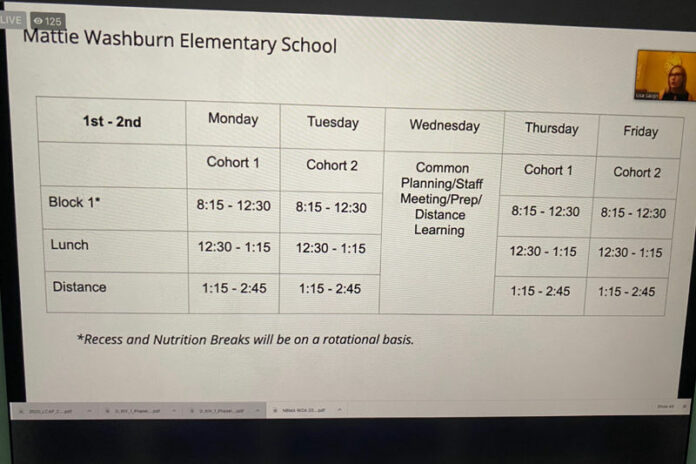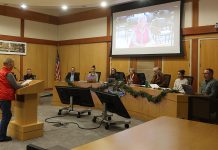Still early days however, and plans could change
At the school board meeting on June 30, the Windsor Unified School District (WUSD) unveiled its plans for a hybrid school reopening model, but took pains to say this was only a draft and subject to change as conditions change and more information is forthcoming.
The initial schedule draft was created by a subcommittee comprised of 30 different stakeholders who met approximately seven times over a 10-day period.
“We created six subcommittees for opening the 2020-21 school year,” said Lisa Saxon, director of educational services. “The first up is the scheduling subcommittee, which we did with the thought that the remaining five would all be hinged to what the schedule will be.”
At each school site, the student body will be split into two cohorts, based on alphabetization of last names and creating a nearly even split. In addition, students in the same households will be put into the same cohorts, regardless of last name, to ensure they are attending school on the same days.
All school sites but one will have two days of in-person learning, and three days of distant learning, with Wednesday as the day when there will be no in-person learning to allow teachers to have time for prepping and working with their peers.
Cohort 1 will attend school in person on Monday and Thursday, and Cohort 2 will attend school in person on Tuesday and Friday. Start and finish times are staggered to allow parents time to move between campuses for pickup and drop off.
The one school site that will continue to meet every day is North Bay Met/Windsor Oaks Academy, which has a small enough enrollment and large enough facilities to keep appropriate social distancing without dividing the student body.
In addition, North County Consortium students will also have school five days a week, though it’s unclear how many will be in person, but their numbers allow for 12 students in a cohort.
The first block of the day is 30 minutes longer than the other in-person educational blocks to ensure time for morning temperature checks and also social-emotional check ins with students each day kids are on campus.
“At the high school, for instance, we still have to figure out taking 825 temperatures first thing in the morning,” Saxon said. “We’re looking into options but it’s going to take time, not everybody will be ready to learn at 8 a.m. And then it also gives them time to work on social emotional learning — circles etcetera — to get the day started.”
Recess, lunch and breaks will take additional planning, but there are some initial plans worked into the schedules.
“For elementary students for recess teachers will provide the supervision and they will be doing a combination of recess and P.E., so it will be more structured to ensure physical distancing is happening,” Saxon said. “Parent feedback was that there was a belief that parents would feel better about teachers taking kids out to structured time and safety being thought about before having them just head out.
“About lunch, the reason for the grab and go concept for elementary was because we were trying to get to as close to the end of distance learning time as possible across all sites,” Saxon continued. “We’re still feeding them, but at the end of day, off they go.
“At the middle school and high school, I asked questions about those unstructured times and making sure physical distancing happened, but keep in mind there will be 50% of the population on campus, therefore there are more places to spread kids out. But I still think it’s a challenge, we have to train kids,” Saxon concluded.
Reached after the meeting, Saxon shared some additional information which is impacting the creation of the schedule.
“The idea is that all students are getting in their required minimum minutes each day (distance or in person). Kinder and continuation high school= 180, 1-3= 230, and 4-12= 240. This includes Wednesdays, when all students will be on distance learning,” Saxon said. “In addition, we learned in the AB 77 trailer language that daily, live interaction with certificated employees and peers for purposes of instruction, progress monitoring, and maintaining social connectedness is required. If it’s not possible, we still need to provide an alternative plan for frequent live interaction that provides a comparable level of service and school connectedness. (Daily live interaction can be internet or telephonic, or other means permissible under public health orders). So, we are thinking along the lines of having the afternoon distance time be for the students who did not attend in person that day. It gets complicated at the secondary level, so that still needs to be ironed out.”
An ongoing concern with the hybrid model is childcare on the days that students are not doing in-person learning, not just because they need some place to go, but also because they need a place to do distance learning if they can’t stay home.
“(We) have been meeting with ECC to see what would it look like to partner with them,” Saxon said. “Space, pricing, what is their amount of qualified staff and how many kids can they accommodate? In addition, how can they partner with us to provide an environment for distance learning three days a week? Students need a place they can show up with their Chromebook and need a space to do distance learning. “
“I think we’re ahead of some districts,” said board president Eric Heitz. “We’ve made a good decision on how to proceed and this gives families some information on what to expect.”
But Saxon wanted to emphasize it’s still early days, and that plans can, and likely will, change.
“It’s important to point out this is the plan right now,” she said. “Once the other committees get ahold of it, if we run into hiccups, there will certainly be some minor tweaking and massaging. But, as with anything, we need to remain flexible. It works until it doesn’t, and we may have to go back to the drawing board.”
To see the specific proposed schedules for each school site, scroll through the attached photos.
Other items from the school board:
- The district said farewell to outgoing Superintendent Brandon Krueger, with a proclamation recognizing his decades of service to education and children.
- A project to revamp an open patch of grass on the high school quad has been met with resistance by student groups who believe they were not effectively included in the planning. However, the board was satisfied that the decisions made to date were made based on students input, and the realistic understanding of what degree of ongoing maintenance is possible. In addition, since the contractor is already staging at the high school, making major changes now would cost additional funds and could delay the project up to a year. The plan calls for shade and seating over a synthetic turf, something some students found objectionable due to environmental sustainability concerns.
- While the state has recently announced significant changes to the proposed budget for schools, it wasn’t done in time to make changes to the budget being sent to the county, which was presented for approval. The changes will be incorporated over the 45-day revise, which begins now.









